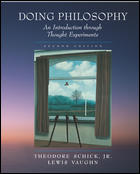 |  Doing Philosophy: An Introduction Through Thought Experiments, 2/e Theodore Schick,
Muhlenberg College
Lewis Vaughn
Feature SummaryNew to This Edition - New sections on logical inference, informal fallacies, and the problem of
perception broaden the scope of the text and give students additional tools
to follow philosophical arguments and construct their own
- Expanded discussions of Searle's Chinese room, non-reductive materialism,
the nature/nurture debate, agent causation, the closest continuer theory,
the divine command theory, the process of ethical decision making, the Kalam
cosmological argument, the fine-tuning argument, the evolution/creationism
controversy, and the problem of skepticism address topics at the forefront
of current research
- New "Thought Probes" throughout each chapter (rather than just
at the end of each section) challenge students to conduct their own thought
experiments
- New readings, including works by Nozick, Taylor, Turing, Davis, Blatchford,
Stace, Kurzweil, Johnson, and Martin
- New biographical boxes provide personal background on important philosophers
covered in the text
Features - More than 75 thought experiments describe the possible situations in which
a particular theory should hold, encouraging students to examine both the
theory and the thought experiment.
- A coherent theoretical framework aids students in their understanding of
contemporary and traditional philosophical problems.
- A selection of classic and contemporary readings at the end of each chapter
provides context for the philosophical theories and thought experiments. Each
set of readings concludes with a piece of fiction which revisits many of the
philosophical questions examined in the chapter.
- Chapter introductions explain the philosophical problem being explored,
define key concepts, and identify chapter objectives.
- Self-contained sections within each chapter include their own summary, study
questions, discussion questions. Additional pedagogy includes a list of suggested
readings at the end of each chapter and a running glossary throughout the
text.
- An energetic writing style, creative examples and exercises, and appealing
quotations and illustrations make this text truly "student-friendly."
|
|



 2003 McGraw-Hill Higher Education
2003 McGraw-Hill Higher Education